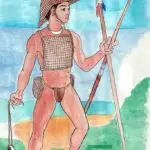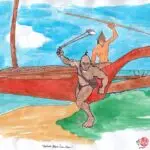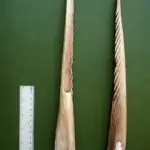Ancient CHamoru/Chamorro Warfare
Table of Contents
Share This
The nature of warfare
In any human society, there are different reasons and circumstances in which people might engage in warfare. Warfare, by definition, is when violence occurs between political entities, such as communities, districts or nations. Scholars talk about different kinds of warfare, which depends on the kinds of entities that actually are at war with each other, the weapons they use, the motivations for fighting and the expected outcomes of conflict. We often think of warfare as large-scale confrontations between groups of people, who strategically plan for attack and defense. But, sometimes, feuding and raiding may be included as types of war strategies.
Feuding is a state of recurring hostilities between families or groups of kin. Such a state exists when families have a shared desire to avenge an offense of some sort—for example, as a result of insult, injury, or death—against another family or its members. Raiding is a short-term, organized effort with a limited objective, such as the acquisition of goods, wealth, or specific resources from another group.
Not much is known about warfare among the prehistoric, pre-Latte Period CHamorus/Chamorros (500 BC to AD 1000). The lack of recognizable weapons in the archeological record might mean that the earliest inhabitants of the Mariana Islands did not engage in warfare, or perhaps, only on a limited scale. The small, dispersed population and the abundant resources would have made warfare unlikely or unnecessary. Nevertheless, by the late Latte Period, the CHamorus had an array of weapons they used to fight each other, and of course, the Spanish during the CHamoru-Spanish wars of the late 17th century.
Latte Period weapons
The practice of warfare on Guam during the Latte Period (approximately AD 800 – AD 1700) left very little direct evidence for the archeologist to uncover, especially before the first contact between CHamoru people and Portuguese explorer Ferdinand Magellan in 1521. Unlike the early Palauans who, in some of the Rock Islands, constructed defensive rock walls, and on the larger islands, built massive terraces and hilltop crowns possibly for their defense, Latte Period settlements of the CHamorus seem to have been built with very little concern for security.
True, some latte sets are found on ridge tops in the interior of southern Guam, but these sites were likely connected to ancient footpaths, although there is little archeological evidence to support this. Still, it is probable that from these ridge top sites, the settlement occupants could see their farms below, as well as their neighbors and cousins on the next ridge top. And while the tallest latte sets on the coast may have provided some security for their inhabitants, the structures that sat atop the latte foundations were just as easy to burn as the smaller houses.
The artifacts of Latte Period warfare are easy to identify since there were no large animals to hunt in the Mariana Islands, and the skillfully crafted weapons were mentioned by early Spanish visitors and settlers to Guam. Slingstones of baked clay, limestone, mudstone, and basalt such as those recovered from the Pågat Village archeological site in central Guam, were found to be deadly at close range, and an effective way to keep the enemy at some distance, even with Spanish shields or armor.
While slingstones are commonly found in small numbers around most coastal Latte Period villages (such as Gogña in Tumon), clusters of them also have been found, particularly in Southern Guam, where basalt cobblestones occur naturally. Archeologists believe these collections of slingstones may have been manufactured with the intent of distributing them more broadly.
One such area of production is the south side of Togcha Bay in Ipan, Guam, where numerous basalt chisels and adzes were also found and another manufacturing area lies on a ridge top near Dandan between the Ugum River valley and the north branch of the Inalåhan River, where most slingstones were made of local mudstone. Some slingstones were also modified for use as net sinker weights, gaming pieces, amulets or ornaments, and as burial goods.
During a battle between two villages on Tinian, in the Northern Marianas, in 1668, Fray Francisco García noted:
Then, if envy would make them want to burn a house from a distance, they would stuff the perforated side of it [the sling] with tow burning with a very ferocious fire, which, with a swift movement became a flame, and sail away to seek shelter in enemy houses.
As protection from slingstones, the Spanish missionaries observed:
Their defensive weapons are hardly more than palm mats, which they place like a hat on their heads by way of a helmet. They also used another [mat] which they tie around their chest by way of a breast-plate, leaving the rest of their body naked; this way they can more easily shoot their sling, or throw spears.
When hand to hand combat was called for, fire hardened or barbed tipped human-shinbone spears such as those found at the Pågat village archeological site could dispatch any enemy foolish enough to get close, and many a wounded warrior returned home to find his wounds infected from poisons on the spear tips. The spears were thrown or could be thrust into an opponent, easily piercing the body. In fact, a number of archeological excavations have unearthed skeletal remains with spear tips lodged in the bones. French explorer Louis Freycinet’s 19th century account described various other weapons that, during times of peace, served as fishing or farming implements, but also could be used in battle. This included the dagau, a rod about two and a half inches in diameter and four and a half feet long made of mangrove timber that was a combination digging stick, pick axe and weapon, and the fisga, which was also a harpoon used for spear fishing.
It appears then, that the simple but effective weapons used by CHamorus during the Latte Period were best suited to a style of warfare that involved small groups of warriors engaging briefly and often at some distance, with the goal being to inflict some damage to the enemy perhaps in an ambush, but then withdraw to fight another day. Such warfare tactics did not result in many casualties. The goal seemed to be to take an aggressive stance if some insult could not be ignored, but then agree to terms that everyone could live with. In 1602, Fray Juan Pobre was told by his Spanish informant Sancho on Rota (a neighboring island) that:
When one kills another, if they are from the same town he absents himself from that town to go to another island so that the relatives will not kill him. He remains absent until from the killer’s house or from that of his father or mother they take one or two palms of tortoise [shells] which is the thing that is most valued among them and with some big fish and rice they pay the father or mother or wife of the deceased for the death. Once this has been done, they send word to the exile and he can come freely and walk about fearlessly through his town and that is their form of justice.
Fray Juan Pobre noted that although occasionally war would break out between different coastal villages, he himself had not witnessed any village quarrels during his seven month stay in Rota.
Another Jesuit missionary of the late 1600s, Father Peter Coomans also described traditional warfare the natives waged among themselves and the terms for peace-making:
Should a palm tree be cut, a harvest pulled out, or if children have a dispute among themselves, this generates a battle between various villages. However, many of these affairs are caused by women. Although they are quick to take up arms, peace can just as easily be arranged between them. As soon as someone is killed by a spear, a truce is declared. Meanwhile the party which did the killing comes up with a tortoise shell, to pay for the death, as these barbarians call it. At the sight of it, hatred subsided, and a peace treaty was renewed.
These early missionary accounts describe CHamoru warfare as essentially between villages over seemingly petty or minor disputes. Battles lasted only a short time and warriors were only loosely organized.
Combat training did appear to be a necessary part of every CHamoru warrior’s life when charged with defending his village and its elders. In fact, young boys began their training early in the use of spears and slings, and frequently competed with each other in village challenges.
Fray Juan Pobre’s informant Sancho noted that:
The young men usually show off their strength in front of these chiefs and they wrestle arms open and make each other tumble. … and thus they test their strength or sometimes they move apart from each other and, although in jest they usually act as earnestly as in fencing. They take some spears at 10 or 12 paces, one throws at the other and although they are skillful at hitting correctly, they are more so in avoiding being hit, and many times they grab the spear in the air…”
No mention is made however, that any CHamoru village maintained a standing army or militia, nor were there obvious officers or insignias of rank during combat, as the Spanish would easily have recognized from their own military training. Nevertheless, the Spanish did observe some aspects and rituals of CHamoru warfare.
Tactics
While Latte Period warfare may not have been ideally suited to confront the organized European style of combat favored by the Spaniards, it is evident that Latte Period warriors were quick to improvise their tactics while fighting an enemy with new and dangerous weapons such as the arquebus, a rather primitive musket. In 1564, Major Esteban Rodriguez noted:
At the beginning, they attacked with great spirit, but as soon as they got a taste of the arquebus, they retreated in disorder as fast as they could run.
However, by the time of the Hagåtña revolt of 1671 Fray Andres de Ledesma observed the CHamorus using new weapons, including wooden shields:
They renewed their efforts and continued their attacks, already using new artifices for their defense; indeed, they used boards of their canoes as a kind of parapets or shields. Under their shelter, they also raise some palisade which encircled ours, trusting the protection of their boards and portable trenches, with which they defend themselves from our fire and attacked with a continuous rain of spears and stones, with such courage that at times they dispatched their spears three at a time…
In the Hagåtña revolt of 1676, Fray Francisco García noted that many:
… came armed with spears and machetes… such as used to kill Fray San Vitores, while one warrior was seen…using a piece of broken arquebus which one of our soldiers had lost.
When Fray Sebastian de Monroy tried to defend himself with a small shield near the village of Sumai in 1676, he was killed in his canoe with these very weapons.
Some degree of defensive planning is also evident where CHamorus would force soldiers to chase them to areas of rough terrain where they would ambush the Spanish or set booby traps for them. In the revolt of 1678 near Haputo, Father García noted that the CHamorus:
…fled from their homes, and had retreated to a cove naturally surrounded by steep cliffs which even the inhabitants had difficulty reaching. There they fixed their residence, trusting in the steepness of the area and the narrow trails that they blocked with branches cut from trees, and by planting here and there poisoned tips of their lances, also placing large rocks in high places and laid out many setups such that they could be pried to make them fall during ambushes.
By the time of the last CHamoru revolt on the island of Saipan in 1695, Father Coomans mentioned that the village of Araiao, south of Chalan Kanoa, was defended:
…not by open force, which they mistrusted, but by hidden traps; for taking advantage of two days during which we were in the north, they had dug pits around the shore and at the entrances of their houses and armed them with bone spear points and fire-hardened stakes, and covered them with branches and leaves and sprinkled sand lightly over them.
Goals changed
From this review of CHamoru warfare practices, especially those recorded at the end of the Latte Period by Spanish observers, it is apparent that warriors on Guam and in the Northern Mariana Islands used time honored methods and traditional weapons to engage in combat with each other, without the expectation of a wholesale slaughter of their enemies from other villages who were, after all, likely their cousins and perhaps the husbands of their sisters.
Pre-Latte Period warfare primarily settled disputes between families, while warfare in the Latte Period probably reflected shifting alliances between families and villages who competed for land and other resources.
But when the Spanish arrived and introduced not only new weapons but a new attitude toward combat with the goal of surrender or be killed, CHamoru warriors adapted their offensive tactics and defenses to meet the challenges and engaged the Spanish in battles over the next 25 years until the final conquest in 1695. Although the typical CHamoru warrior was physically stronger than the Spanish or Filipino soldier, the advanced weaponry of the Spanish, as well as the traditional tactics of native warfare made it difficult for CHamorus to prevail over their opponents.
Perhaps, had they adopted the use of firearms and were they able to purchase a ready supply of gunpowder from traders or more likely privateers, the history of the Marianas may well have been written by the CHamoru and not the Spanish.
Video
Word list
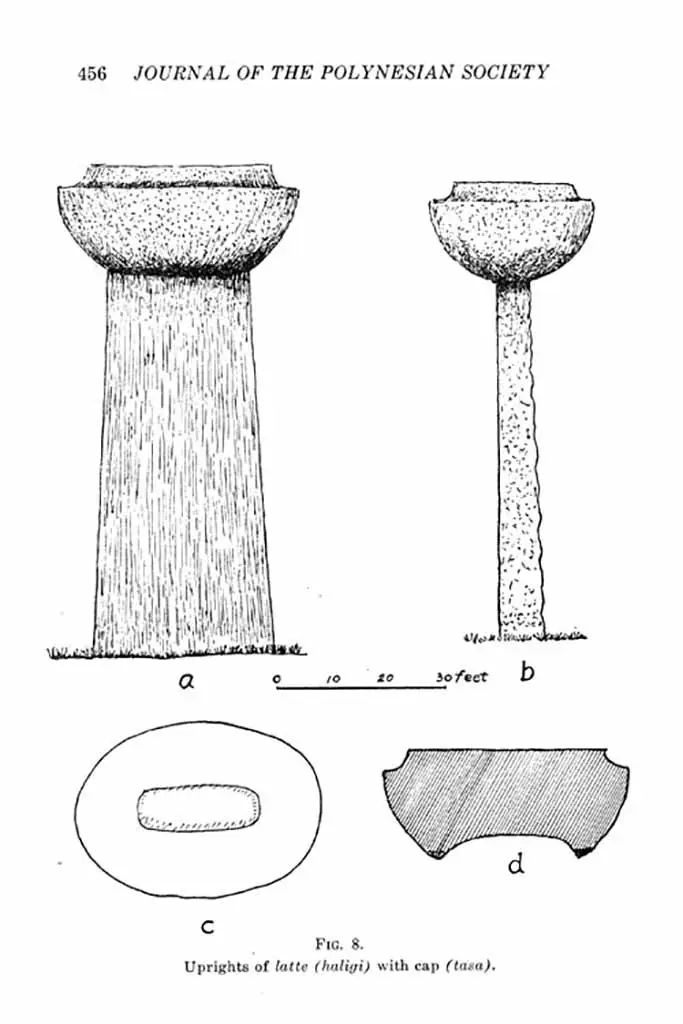
Latte – a stone structure composed of a semi-hemispherical capstone and a pillar. Sets of latte were used as housing supports, and they dominated the archeological landscape of the Mariana islands.
Slingstones – CHamorus were skilled at using these oblong-shaped stones as weapons. Jesuit missionary Father Peter Coomans wrote about how warriors aimed their slingstones at an enemy’s head or chest, and literally flattening him “on the spot.”
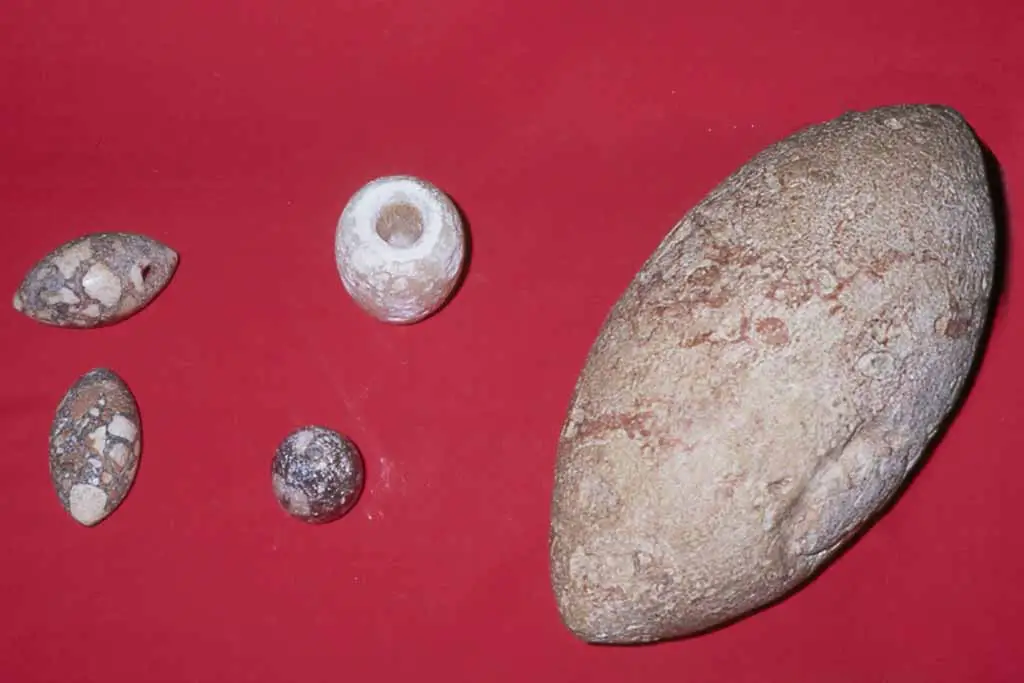
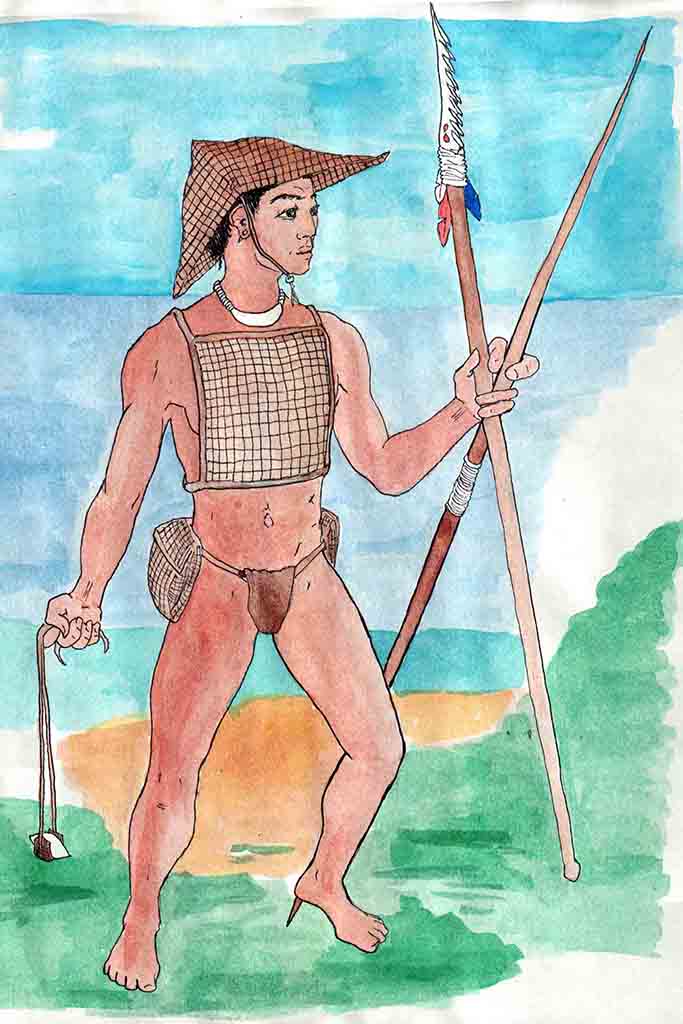
War Tactics – The CHamorus also used deception to plan their attacks on the Spanish soldiers or priests. Missionary accounts noted that CHamorus would lure the Spanish under false pretenses or by feigning friendship with them and lead them into dangerous and deadly situations. For example, one story described how CHamorus offered to transport a contingent of Spanish soldiers by canoe, but instead capsized the vessel and killed them.
For further reading
Barratt, Glynn. The Chamorros of the Mariana Islands: The Early European Records, 1521-1721. Saipan, CNMI: CNMI Division of Historic Preservation, 2003.
Craib, John L. “Casas de los Antiguos: Social Differentiation in Protohistoric Chamorro Society, Mariana Islands.” PhD diss., University of Sydney, 1986.
Lévesque, Rodrigue, comp. and ed. History of Micronesia: A Collection of Source Documents. Vols. 1 – 8. Gatineau, Quebec: Lévesque Publications, 1992-.
Osborne, D. Chamorro Archaeology. 1947. An unpublished typescript can be found in the files of the Richard F. Taitano, Micronesian Area Research Center, University of Guam, Mangilao, Guam.
Reinman, Fred. An Archaeological Survey and Preliminary Test Excavations on the Island of Guam, Mariana Islands, 1965-1966. Mangilao, Guam: University of Guam Richard F. Taitano Micronesian Area Research Center, 1977.
Russell, Scott. Tiempon I Manmofo’na: Ancient Chamorro Culture and History of the Northern Mariana Islands. Micronesian Archaeological Survey Report No. 32. Saipan, CNMI: Division of Historic Preservation, 1998.
Thompson, Laura M. Archaeology of the Mariana Islands. Bernice P. Bishop Museum Bulletin 100. Honolulu: Bernice P. Bishop Museum, 1932.

